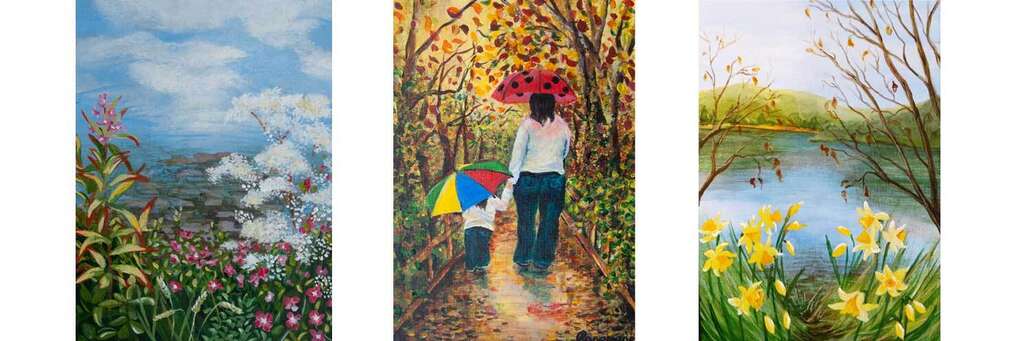Don't Pour Acrylic Paint Down The Drain
 Acrylic sludge build up from painting
Acrylic sludge build up from painting
Protect The Environment And Don't Pour Acrylic Paint Down The Drain
I love acrylic paint as a medium. It's vibrant and flexible enough for different techniques. Acrylic though is plastic paint. When we paint with acrylics, we rinse our brushes in a tub of water. Each time we rinse, we deposit acrylic particles in the water . If you pour all this down the drain, gradually over time there will be a build up of acrylic sludge. It's not good for your drain and it's definitely not good for the environment.
So how do I dispose of waste acrylic responsibly?
After I have finished for the day, I leave my rinsing jar complete with dirty water to one side. Over night the acrylic particles settle to the bottom. The next day, carefully, and without disturbing the sediment, I gentle pour the almost clear water away taking care to leave the sludge in the bottom of the jar. I then wipe the sludge up with a paper towel and bin it You'll be amazed how much there is.
It helps to use wide jars or tubs, wide enough to get your hands in. I always have two tubs on the go when painting, one for rinsing paint off my brush and the other for thinning, or priming my brush for fresh paint, which is clean water.
This photo is an example of just one days painting of sludge being left to dry. I scraped a bit off just to show how easy it could build up in your sewage pipes! Also, it's better in the bin than in the water course.
Experimenting With Different Art Techniques
 Having Fun Experimenting with Book Making and Paper Cutting
Having Fun Experimenting with Book Making and Paper Cutting
Having Fun Experimenting With Different Art Techniques
I'm a painter first and foremost, but when I can, I take the opportunity to go on a workshop by an artist working in a different medium. Not necessarily because I want to work in that way, but to open my eyes to new possibilities in my own work, a sort of cross pollination of ideas and techniques.
ME CFS And How I'm Learning To Live With It
 Peace lilies sketch in response to ME CFS
Peace lilies sketch in response to ME CFS
I'm writing this blog because there is a silent group out there who have daily struggles that others are completely unaware of. I don't often talk about my "disability" because it puts me in a box, but very occasionally I feel the need to shout it from the roof tops.
Artist Residency And The Micro World At The Workers Gallery
 Sketch Book and Microscope Ready for Art Studies
Sketch Book and Microscope Ready for Art Studies
During the World of Work Exhibition March/April 2016 at the Workers Gallery and Workshops in Ynyshir, South Wales I held two drop in artist residencies. The purpose was to just be there to answer questions about my work and show how my art was taking another turn from my studies of the microscopic.
Learning For Myself Was The Only Way
 Learning Computer Skills Takes Time and Dedication
Learning Computer Skills Takes Time and Dedication
Sometimes I wonder how much more I need to learn. In the grand scheme of things, I actually love learning, though nowadays with M.E./CFS it takes me much longer and I make lots more notes! My website is a classic example.
Twitter Art Exhibition 2016 New York USA
 Twitter Art Exhibition Donated Paintings
Twitter Art Exhibition Donated Paintings
Twitter Art Exhibition 2016 Charitable Art Donations For Great Causes
It's time to come out of my shell and reconnect with the world, and for once, the sun is shining! There comes a point when I get fed up of being poorly, and even though I still am, I can somehow handle it better when the sun shines.
When Science Meets Art
 Studying with the microscope
Studying with the microscope
When Science Meets Art The Possibilities Are Endless
My love of science at school paralleled my love of art. Flowers have always been a source of inspiration for me, and now I can zoom in far beyond what the eye can see. I have a microscope! But it’s not quite as straight forward as that, so I am in the process of learning a new skill (making specimen slides) in order to take my nature paintings to another level.
Art Cards Editions And Originals ACEOs And Artist Trading Cards
 Variety of my artist trading cards
Variety of my artist trading cards
Art Cards, Editions and Originals are miniature art. Fun to do and a challenge if you are used to painting big! They are also known as Artist Trading Cards.
Artist Trading Cards were originally used in the old days by artists to give to prospective customers, a bit like the business cards of today, except they were miniature originals. Nowadays, Artist Trading Cards tend to be swapped amongst artists, or still given to prospective clients as small gifts. There is one rule, they must measure 2.5 x 3.5 inches.
More Articles …
Page 6 of 7